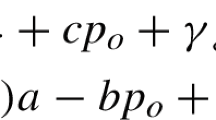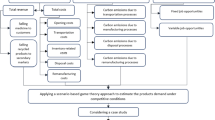Abstract
Capacity acquisition and pricing decisions are a company’s long-term strategic decisions. However, demand uncertainty and substitutability of multiple products cause the difficulty to solve capacity and pricing decision problems. In this paper, we address a multiple product pricing and multiple resource capacity acquisition problem with demand uncertainties and competition. The company needs to determine capacity commitment for each resource and product prices before demands are realized so that the total profit is maximized. If the demand exceeds the committed capacity, extra amounts can be purchased from the spot market. Variable unit production costs, capacity acquisition and maintenance costs are considered. We first analyze a single company basic problem and find the optimal solutions on prices and capacity. Based on the single company model, we address the two-product, two-firm capacity commitment and pricing problem considering across product and across company price competition factors. The existence and uniqueness of equilibrium on price and capacity commitment are proved, and then we extended the results to the multiple product, multiple company case.
Similar content being viewed by others
References
Ahmet, K.H. & Ioana, P. (2006). Deterministic price-inventory management for substitutable products. Journal of Revenue and Pricing Management, 4(4): 354–366
Alptekinôglu, A. & Corbett, C.J. (2008). Mass customization vs. mass production: variety and price competition. Manufacturing & Service Operations Management, 10(2): 204–217
Aydin, G. & Porteus, E.L. (2008). Joint inventory and pricingdecisions for an assortment. Operations Research, 56(5): 1247–1256
Aydin, G. & Ryan, J.K. (2002). Product line selection and pricing under the multinomial logit choice model. Working Paper, Standford University
Banker, R. & Hugnes, J.S. (1994). Product costing and pricing. The Accounting Review, 69(3): 479–494
Banker, R., Hwang, I. & Misha, B.K. (2002). Product costing and pricing under long-term capacity commitment. Journal of Management Accounting Research, 14: 79–97
Bernstein, F. & DeCroix, G.A. (2004). Decentralized pricingand capacity decisions in a multitier system with modular assembly. Management Science, 50(9): 1293–1308
Bernstein, F. & Federgruen, A. (2004). A general equilibrium model for industries with price and service competition. Operations Research, 52(6): 868–886
Bertsimas, D. & de Boer, S. (2005). Dynamic pricing and inventory control for multiple products. Journal of Revenue and Pricing Management, 3(4): 303–319
Birge, J., Drogosz, J. & Duenyas, I. (1998). Setting single-period optimal capacity levels and prices for substitutable products. The International Journal of Flexible Manufacturing Systems, 10: 407–430
Bitran, G., Caldentey, R. & Vial, R. (2009). Pricing policiesfor perishable products with demand substitution. Working paper, MIT
Dong, L., Kouvelis, P. & Tian, Z. (2009). Dynamic pricing and inventory control of substitute products. Manufacturing & Service Operations Management, 11(2): 317–339
Gallego, G., Huh, W.T., Kang, W. & Philips, R. (2006). Price competition with the attraction demand model: existence of unique equilibrium and its stablity. Manufacturing & Service Operations Management, 8(4): 359–375
Kuyumcu, H.A. & Popescu, L. (2005). Deterministic price — inventory management for sub-stitutable products. Journal of Revenue and Pricing Management, 4(4): 354–366
Maddah, B. & Bish, E.K. (2007). Joint pricing, assortment, and inventory decisions for a retailer’s product line. Naval Research Logistics, 54(2): 315–330
Maglaras, C. & Meissner, J. (2006). Dynamic pricing strategies for multi-product revenue management problems. Manufacturing & Service Operations Management, 8(2): 136–148
Netessine, S. & Rudi, N. (2003). Centralized and competitive inventory models with demand substitution. Operations Research, 51(2): 329–335
Rajaram, K. & Tang, C.S. (2001). The impact of product substitution on retail merchandising. European Journal of Operations Research, 135: 582–601
Song, J.-S. & Xue, Z. (2007). Demand management and inventorycontrol for substitutable products. Working paper, Duke University
Suh, M. & Aydin, G. (2009). Dynamic pricing of substituable products with limited inventories under logit demand. Working paper, University of Michigan
Sundaram, R.K. (1996). A First Course in Optimization Theory. Cambridge University Press, Cambridge, UK
Tang, C.S. & Yin, R. (2007). Joint ordering and pricing strategies for managing substitutable products. Production and Operations Management, 16(1): 138–153
Topkis, D.M. (1998). Supermodularity and Complementarity. Princeton University Press, New Jersey, US
Vives, X. (1990). Nash equalibrium with startegic complementarities. Journal of Mathematical Economics, 19: 305–321
Vives, X. (1999). Oligopoly Pricing: Old Ideas and New Tools. The MIT Press, Cambridge, MA
Zhu, K. & Thonemann, U. (2009). Coordination of pricing and inventory control across products. Naval Research Logistics, 56(2): 175–190
Author information
Authors and Affiliations
Corresponding author
Additional information
This research was partly supported by National Nature Science Foundation of China (71101021 and 71271049), Post-Doctor Science Foundation of China (20110490144), and Humanities and Society Science Plan Foundation of Ministry of Education of China (11YJA630180).
Hongyan Li received B.E. degree in statistics from Northeastern University (NEU), Shenyang, China in 1997, M.S. degree in Management Science and Engineering from NEU in 2000, and Ph.D. degree from Lancaster University Management School, Lancaster University, UK, 2007. She is currently an associate professor at the Department of Management Science and Engineering, School of Business Administration in NEU. Her primary research interests are in supply chain management and revenue management. She is also a member of INFORMS and POMS, and has publish a number of papers in internationally recognized journals in OR area.
Tianhui You received the B.E. degree in science and technology information engineering from Jilin University of Technology, Changchun, China in 1990, the M.S. degree in enterprise management from Northeastern University (NEU), Shenyang, China in 1998, and Ph.D. degree in management science and engineering from NEU in 2004. She is currently an associate professor in the Department of Management Science and Engineering, School of Business Administration, NEU. Her current research interests include decision analysis, knowledge management and operations research.
Rights and permissions
About this article
Cite this article
Li, H., You, T. Capacity commitment and pricing for substitutable products under competition. J. Syst. Sci. Syst. Eng. 21, 443–460 (2012). https://doi.org/10.1007/s11518-012-5204-3
Published:
Issue Date:
DOI: https://doi.org/10.1007/s11518-012-5204-3




